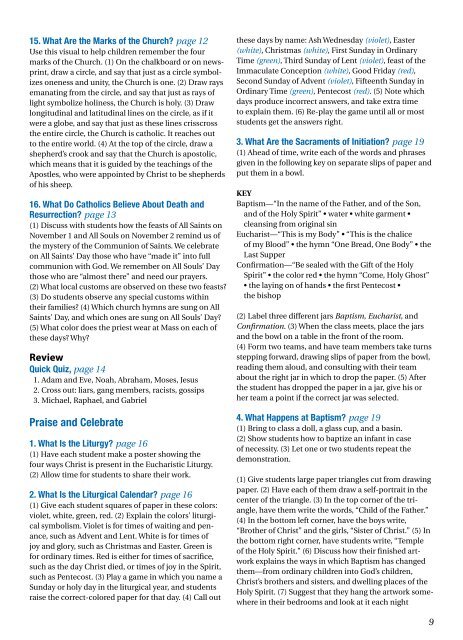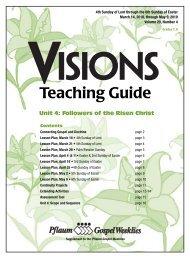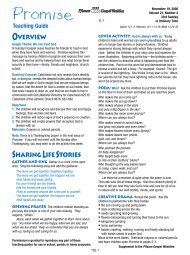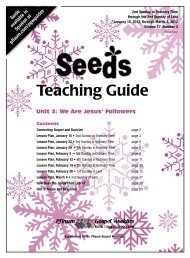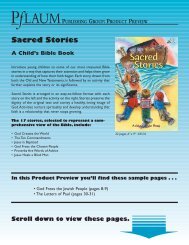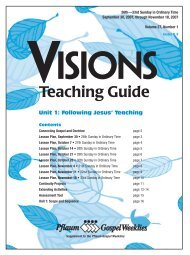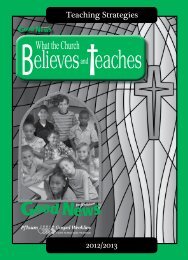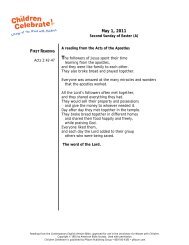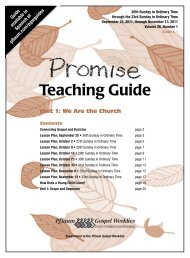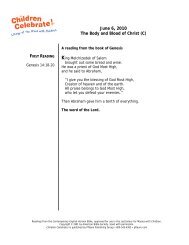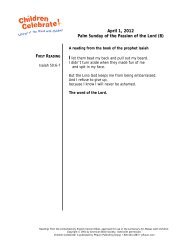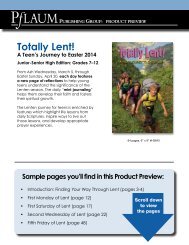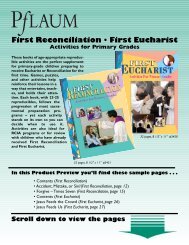Venture - Pflaum Gospel Weeklies
Venture - Pflaum Gospel Weeklies
Venture - Pflaum Gospel Weeklies
You also want an ePaper? Increase the reach of your titles
YUMPU automatically turns print PDFs into web optimized ePapers that Google loves.
15. What Are the Marks of the Church? page 12<br />
Use this visual to help children remember the four<br />
marks of the Church. (1) On the chalkboard or on newsprint,<br />
draw a circle, and say that just as a circle symbolizes<br />
oneness and unity, the Church is one. (2) Draw rays<br />
emanating from the circle, and say that just as rays of<br />
light symbolize holiness, the Church is holy. (3) Draw<br />
longitudinal and latitudinal lines on the circle, as if it<br />
were a globe, and say that just as these lines crisscross<br />
the entire circle, the Church is catholic. It reaches out<br />
to the entire world. (4) At the top of the circle, draw a<br />
shepherd’s crook and say that the Church is apostolic,<br />
which means that it is guided by the teachings of the<br />
Apostles, who were appointed by Christ to be shepherds<br />
of his sheep.<br />
16. What Do Catholics Believe About Death and<br />
Resurrection? page 13<br />
(1) Discuss with students how the feasts of All Saints on<br />
November 1 and All Souls on November 2 remind us of<br />
the mystery of the Communion of Saints. We celebrate<br />
on All Saints’ Day those who have “made it” into full<br />
communion with God. We remember on All Souls’ Day<br />
those who are “almost there” and need our prayers.<br />
(2) What local customs are observed on these two feasts?<br />
(3) Do students observe any special customs within<br />
their families? (4) Which church hymns are sung on All<br />
Saints’ Day, and which ones are sung on All Souls’ Day?<br />
(5) What color does the priest wear at Mass on each of<br />
these days? Why?<br />
Review<br />
Quick Quiz, page 14<br />
1. Adam and Eve, Noah, Abraham, Moses, Jesus<br />
2. Cross out: liars, gang members, racists, gossips<br />
3. Michael, Raphael, and Gabriel<br />
Praise and Celebrate<br />
1. What Is the Liturgy? page 16<br />
(1) Have each student make a poster showing the<br />
four ways Christ is present in the Eucharistic Liturgy.<br />
(2) Allow time for students to share their work.<br />
2. What Is the Liturgical Calendar? page 16<br />
(1) Give each student squares of paper in these colors:<br />
violet, white, green, red. (2) Explain the colors’ liturgical<br />
symbolism. Violet is for times of waiting and penance,<br />
such as Advent and Lent. White is for times of<br />
joy and glory, such as Christmas and Easter. Green is<br />
for ordinary times. Red is either for times of sacrifice,<br />
such as the day Christ died, or times of joy in the Spirit,<br />
such as Pentecost. (3) Play a game in which you name a<br />
Sunday or holy day in the liturgical year, and students<br />
raise the correct-colored paper for that day. (4) Call out<br />
these days by name: Ash Wednesday (violet), Easter<br />
(white), Christmas (white), First Sunday in Ordinary<br />
Time (green), Third Sunday of Lent (violet), feast of the<br />
Immaculate Conception (white), Good Friday (red),<br />
Second Sunday of Advent (violet), Fifteenth Sunday in<br />
Ordinary Time (green), Pentecost (red). (5) Note which<br />
days produce incorrect answers, and take extra time<br />
to explain them. (6) Re-play the game until all or most<br />
students get the answers right.<br />
3. What Are the Sacraments of Initiation? page 19<br />
(1) Ahead of time, write each of the words and phrases<br />
given in the following key on separate slips of paper and<br />
put them in a bowl.<br />
KEY<br />
Baptism—“In the name of the Father, and of the Son,<br />
and of the Holy Spirit” • water • white garment •<br />
cleansing from original sin<br />
Eucharist—“This is my Body” • “This is the chalice<br />
of my Blood” • the hymn “One Bread, One Body” • the<br />
Last Supper<br />
Confirmation—“Be sealed with the Gift of the Holy<br />
Spirit” • the color red • the hymn “Come, Holy Ghost”<br />
• the laying on of hands • the first Pentecost •<br />
the bishop<br />
(2) Label three different jars Baptism, Eucharist, and<br />
Confirmation. (3) When the class meets, place the jars<br />
and the bowl on a table in the front of the room.<br />
(4) Form two teams, and have team members take turns<br />
stepping forward, drawing slips of paper from the bowl,<br />
reading them aloud, and consulting with their team<br />
about the right jar in which to drop the paper. (5) After<br />
the student has dropped the paper in a jar, give his or<br />
her team a point if the correct jar was selected.<br />
4. What Happens at Baptism? page 19<br />
(1) Bring to class a doll, a glass cup, and a basin.<br />
(2) Show students how to baptize an infant in case<br />
of necessity. (3) Let one or two students repeat the<br />
demonstration.<br />
(1) Give students large paper triangles cut from drawing<br />
paper. (2) Have each of them draw a self-portrait in the<br />
center of the triangle. (3) In the top corner of the triangle,<br />
have them write the words, “Child of the Father.”<br />
(4) In the bottom left corner, have the boys write,<br />
“Brother of Christ” and the girls, “Sister of Christ.” (5) In<br />
the bottom right corner, have students write, “Temple<br />
of the Holy Spirit.” (6) Discuss how their finished artwork<br />
explains the ways in which Baptism has changed<br />
them—from ordinary children into God’s children,<br />
Christ’s brothers and sisters, and dwelling places of the<br />
Holy Spirit. (7) Suggest that they hang the artwork somewhere<br />
in their bedrooms and look at it each night<br />
9


